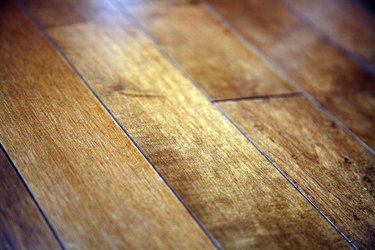
Nobody likes to see polyurethane peel, especially just after refinishing the floor. Before you act, you need to identify the issues. For example, it's not uncommon for old floors to start peeling as the old polyurethane topcoat starts to deteriorate. Ultimately, you will most likely have to refinish the floor if the polyurethane won't stop peeling.
The First Coat
Video of the Day
It 's very common for polyurethane to bubble up a bit after you apply the first coat, even if the stain underneath is perfectly dry. If this is your situation, don't jump to the conclusion that you're going to have to refinish the floor -- this is most likely not the case. Just sand down the bubbles with 200-grit sandpaper once the polyurethane dries -- this varies by manufacturer and weather conditions. Sweep up any dust and paint on another coat of polyurethane.
Video of the Day
Second and Third Coats
If your polyurethane continues to bubble and peel after the second or even third coat, either the stain wasn't dry before you started applying the topcoat, or the conditions are too humid. If this is the case, you are going to have to refinish the floor. Stain should be left to dry completely before polyurethane topcoats are added. If you're experiencing heavy rain or humidity, hold off on refinishing the floor until drier weather comes around.
Removing the Finish
Whether you're dealing with an old floor with deteriorating polyurethane or a newly refinished floor that hasn't dried properly, you have to remove the finish. You can do this by sanding with a drum sander -- use an orbital sander for older, warped floors -- or with chemicals, such as mineral spirits and other stain strippers. If you go the chemical route, make sure the room is well ventilated before you start. For best results, follow all instructions as directed by the manufacturer for any product you use.
Restaining
When the floor is clean and dry, you can safely restain it. Spread the stain as thinly as you can. As you finish staining each section of floor, wipe the floor with a clean rag to soak up any excess stain. It's better to have to paint on extra coats that will actually dry, than to saturate the floor with a coat that doesn't dry, which will lead to your polyurethane peeling again. Allow every coat to dry completely before adding another.
Resealing
With the stained floor absolutely dry, you can reseal it. If you're still experiencing humid conditions, install a dehumidifier and fans to improve air circulation, which will help the floor dry faster. For best results, make sure your polyurethane is compatible with the stain you're using. For example, if you used an oil-based stain, use an acrylic- or oil-based polyurethane topcoat. If you were using a water-based polyurethane over an oil-based stain, that could also explain why the polyurethane was peeling.